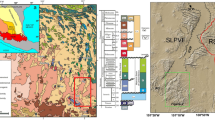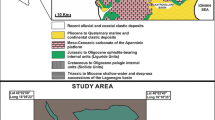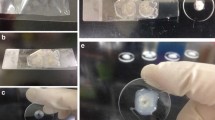Abstract
Erionite is a human and animal carcinogen and one of the most toxic minerals known. Erionite deposits have been reported in many countries; however, it is only in the area of three villages of Cappadocia, Turkey, that environmental exposure to erionite has been demonstrated to be the cause of an epidemic of the disease mesothelioma. In the USA, no cases of mesothelioma have been reliably proven to be the result of erionite exposure, though the possibility exists. Erionite samples from three villages of the Cappadocia region were characterized mineralogically and compared with three different standards from the USA. Micro morphological details of erionite minerals using a high-resolution field-emission SEM showed that microstructures of “bundles”, “fibers”, and “fibrils” are important physical properties of fibrous erionite minerals. Typical lung burden of erionite and asbestos fibers were compared in terms of number of fibers. Assuming the lung burden of fibers in a human mesothelioma victim is about 1 mg, and the hazardous fibers are approximately 1 μm in diameter and 10 μm long, that milligram contains approximately 40 million asbestos and 50 million erionite fibers. These microstructures of erionite minerals draw attention to the concepts of surface area or surface-area-to-volume ratio and their relationship to the carcinogenicity of the mineral. The larger surface area creates a wider platform for mineral–cell interaction and thus more possibilities of proliferative transformation of mesothelial cells. Consequently, understanding the exact mineralogical properties will help determination of the true carcinogenic mechanism(s) of the mineral for prevention and possibly treatment of malignant mesothelioma.

Similar content being viewed by others
References
Aiello, R., & Barrer, R. M. (1970). Hydrothermal chemistry of silicates. Part XIV Zeolite crystallization in presence of mixed bases. Journal of the Chemical Society London, Sec A, 1470–1475.
Alberti, A., Martucci, A., Galli, E., & Vezzalini, G. (1997). A reexamination of the crystal structure of erionite. Zeolites, 19, 349–352.
Artvinli, M., & Baris, Y. I. (1979). Malignant mesothelioma in a small village in the Anatolian region of Turkey: An epidemiological study. Journal of the National Cancer Institute, 63, 17–22.
Artvinli, M., & Baris, Y. I. (1982). Environmental fibre-induced pleura-pulmonary diseases in an Anatolian village: An epidemiological study. Archives of Environmental Health, 37, 177–181.
Artvinli, M., & Baris, Y. I. (1985). Erionite related disease in Turkey. In E. G. Beck, & J. Bignon (Eds.), In vitro effects of mineral dusts, NATO ASI series (pp. 515–519). Berlin: Springer, G3.
Baris, Y. I. (1991). Fibrous zeolite (erionite) related diseases in Turkey. American Journal of Industrial Medicine, 19(3), 374–378.
Baris, Y. I., Artvinli, M., & Sahin, A. A. (1979). Environmental mesothelioma in Turkey. Annual Academy of Science, 330, 423–432.
Baris, Y. I., Sahin, A. A., Ozesmi, M., Kerse, I., Ozen, E., Kolacan, B., Altinors, M., & Goktepeli, A. (1978). An outbreak of pleural mesothelioma and chronic fibrosing pleurisy in the village of Karain/Urgup in Anatolia. Thorax, 33, 181–192.
Baris, Y. I., Saracci, R., Simonato, L., Skidmore, J. W., & Artvinli, M. (1981). Malignant mesothelioma and radiological chest abnormalities in two villages in central Turkey: An epidemiological and environmental investigation. Lancet, 2, 984–987.
Baris, Y. I., Simonato, L., Artvinli, M., Pooley, F., Saracci, R., Skidmore, J., & Wagner, C. (1987). Epidemiological and environmental evidence of the health effects of exposure to erionite fibres: A four-year study in the Cappadocian region of Turkey. International Journal of Cancer, 39, 10–17.
Bennett, J. M., & Gard, J. A. (1967). Non-identity of the zeolites erionite and offretite. Nature, 214, 1005–1006.
Bertino, P., Marconi, A., Palumbo, L., Bruni, B. M., Barbone, D., Germano, S., Dogan, A. U., Tassi, G. F., Porta, C., Mutti, L., & Gaudino, G. (2007). Erionite and asbestos differently cause transformation of human mesothelial cells. International Journal of Cancer, 121(1), 2766–2774.
Boles, J. R., & Surdam, R. C. (1979). Diagenesis of volcanogenic sediments in a Tertiary saline lake, Wagon Bed Formation, Wyoming. American Journal of Science, 279, 832–853.
Boman, G., Schubert, V., Svane, B., Westernholm, P., Bolinder, E., Rohl, A. N., & Rischbein, A. (1982). Malignant mesothelioma in Turkish immigrant residing in Sweden. Scandinavian Journal of Workers Environmental Health, 8, 108–112.
Carbone, M., Emri, S., Dogan, A. U., Steele, I., Tuncer, M., Pass, H. I., & Baris, Y. I. (2007). A mesothelioma epidemic in Cappadocia: Scientific developments and unexpected social outcomes. Nature Reviews Cancer, 7, 147–154.
Carbone, M., Kratzke, R. A., & Testa, J. R. (2002). The Pathogenesis of Mesothelioma. Seminars in Oncology, 29(1), 2–17.
Carbone, M., Setlak, P., Bocchetta, M., Rizzo, P., Emri, S., Baris, Y. I., Pass, H. I., Testa, J. R., & Dogan, A. U. (2001). Genetic Susceptibility to Mesothelioma. In G. A. Peters, & B. J. Peters (Eds.), The asbestos legacy—the sourcebook on asbestos diseases (Vol. 23, pp. 151–168), LexisNexis, Release no. 23, December 2001, Pub. 82410, Matthew Bender & Co. Inc.
Carthew, P., Hill, R. J., Edwards, R. E., & Lee, P. N. (1992). Intrapleural administration of fibres induced mesothelioma in rats in the same relative order of hazard as occurs in man after exposure. Human Experimental Toxicology, 11, 530–534.
Casey, K. R., Moatamed, F., Shigeoka, J., & Rom, W. N. (1981). Demonstration of fibrous zeolite in pulmonary tissue. American Review of Respiratory Diseases, 123, 98 (abstract).
Casey, K. R., Shigeoka, J., Rom, W. N., & Moatamed, F. (1985). Zeolite exposure and associated pneumoconiosis. Chest, 87, 837–840.
Clifton, R. A. (1984). Other non-metals. In Minerals yearbook, Vol. 1. Metals and minerals (pp. 1030–1034). Washington, DC: U.S. Bureau of Mines, U.S. Government Printing Office.
Clifton, R. A. (1985). Other non-metals. In Minerals yearbook, Vol. 1. Metals and minerals. Washington, DC: U.S. Bureau of Mines, U.S. Government Printing Office.
Clifton, R. A. (1986). Other non-metals. In Minerals yearbook, Vol. 1. Metals and Minerals. Washington, DC: U.S. Bureau of Mines, U.S. Government Printing Office.
Coombs, D. S., Alberti, A., Armbruster, T., Artioli, G., Cocella, C., Galli, E., Grice, J. D., Liebau, F., Mandarino, J. A., Minato, H., Nickel, E. H., Passaglia, E., Peacor, D. R., Quartieri, S., Rinaldi, R., Ross, M., Sheppard, R. A., Tillmanns, E., & Vezzalini, G. (1997). Recommended nomenclature for zeolite minerals: Report of the subcommittee on zeolites of the international mineralogical association, commission on new minerals and mineral names. The Canadian Mineralogist, 33, 1571–1606.
Davis, J. M. G., Bolton, R. E., Miller, B. G., & Niven, K. (1991). Mesothelioma dose response following intraperitoneal injection of mineral fibres. International Journal of Experimental Pathology, 72, 263–274.
Dogan, A. U. (2003a). Mesothelioma in Cappadocian villages. Indoor and Built Environment, 12, 367–375.
Dogan, M. (2003b). Sources and types of mineral dust in regions of Turkey with endemic malignant mesothelioma. Indoor and Built Environment, 12(6), 377–383.
Dogan, A. U., Baris, Y. I., Dogan, M., Emri, S., Steele, I., Elmishad, A. G., & Carbone, M. (2006). Genetic predisposition to fiber carcinogenesis causes a mesothelioma epidemic in Turkey. Cancer Research, 66(10), 5063–5068.
Dogan, A. U., & Dogan, M. (2008). Re-evaluation and re-classification of eronite series minerals. Environmental Geochemistry and Health, doi:10.1007/s10653-008-9163-z
Dogan, A. U., Dogan, M., & Baris, Y. I. (2000). Environmental mineralogy and mesothelioma in Cappadocia region, Turkey. In The mediterranean: Culture, environment and society (pp. 145–148). Israel: University of Haifa. International Colloquium.
Durnev, A. D., Daugel-Dauge, N. O., Korkina, L. G., & Seredenin, S. B. (1990). Peculiarities of the clastogenic properties of chrysotile-asbestos fibres and zeolite particles. Mutation Research, 319, 303–308.
Durnev, A. D., Suslova, T. B., Cheremisina, Z. P., Dobovskaya, O., Nigarrova, E. A., Korkina, L. G., Seredenin, S. B., & Velitchkovskij, B. T. (1993). Investigation of mutagenic action of natural zeolite and chrysotile-asbest dusts. Experimental Oncology, 12, 21–24.
Emri, S., Demir, A., Dogan, M., Akay, H., Bozkurt, B., Carbone, M., & Baris, I. (2002). Lung diseases due to environmental exposures to erionite and asbestos in Turkey. Toxicology Letters, 127, 251–257.
EPA-US (1988). Environmental protection agency. Methodology for evaluating potential carcinogenicity in support of reportable quantity adjustments pursuant to CERCLA section 102. Environmental Protection Agency, Washington D.C. Office of Health and Environmental Assessment Report No. EPA/600/8–89/053.
Gard, J. A., & Tait, J. M. (1973). Refinement of the crystal structure of erionite. In J. B. Uytterhoeven (Ed.), Proc 3rd Int Conf Mol Sieves (pp. 94–99). Leuven: Leuven University Press.
Gualtieri, A., Artioli, G., Passaglia, E., Bigi, S., Viani, A., & Hanson, J. C. (1998). Crystal structure-crystal chemistry relationships in the zeolites erionite and offretite. American Mineralogist, 83, 590–606.
Gude, A. J., & Sheppard, R. A. (1981). Woolly erionite from the Reese River zeolite deposit, Lander County, Nevada, and its relationship to other erionites. Clays and Clay Minerals, 29, 378–384.
Harada, K., Iwamoto, S., & Kihara, K. (1967). Erionite, phillipsite, and gonnardite in the amygdules of altered basalt from Maze, Niigata prefecture, Japan. American Mineralogist, 52, 1785–1794.
Harben, P. W., & Bates, R. L. (1984). Geology of the non-metallics (pp. 311–316). Metal Bulletin, New York.
Hey, M. H., & Fejer, E. E. (1962). The identity of erionite and offretite. Mineralogical Magazine, 33, 66–67.
Hill, R. J., Edwards, R. E., & Carthew, P. (1990). Early changes in the Pleural Mesothelium following Intrapleural Inoculation of the mineral fibre erionite and the subsequent development of mesotheliomas. Journal of Experimental Pathology, 71, 105–118.
Hillerdal, G., & Baris, Y. I. (1983). Radiological study of pleural changes in relation to mesothelioma in Turkey. Thorax, 38, 443–448.
IARC (1987a). International Agency for Research on Cancer. IARC Monographs on the evaluation of carcinogenic risks to humans. Silica and some silicates (Vol. 42, 289 pp.). Lyon, France.
IARC (1987b). International Agency for Research on Cancer. IARC Monographs on the evaluation of carcinogenic risks to humans. Overall evaluations of carcinogenicity, Supplement 7 (440 pp.). Lyon, France.
Kamb, W. B., & Oke, W. C. (1960). Paulingite, a new zeolite, in association with erionite and filiform pyrite. American Mineralogist, 45, 79–91.
Kawahara, A., & Curien, H. (1969). La structure cristalline de l’érionite. Bulletin de la Societe Francaise de Mineralogie et de Cristallographie, 92, 250–256.
Kelsey, K. T., Yano, E., Liber, H. L., & Liftle, J. B. (1986). The in vitro genetic effects of fibrous erionite and crocidolite asbestos. British Journal of Cancer, 54, 107–114.
Kemesis, P. (1999). No finale for phosphates. Chemical Week, 161(4), 31–32.
Kerr, I. S., Gard, J. A., Barrer, R. M., & Galabova, I. M. (1970). Crystallographic aspects of the co-crystallization of zeolite L, offretite and erionite. American Mineralogist, 55, 441–454.
Kokotailo, G. T., Sawruk, S., & Lawton, S. L. (1972). Direct observation of stacking faults in the zeolite erionite. American Mineralogist, 57, 439–444.
Leanderson, P., & Tagesson, C. (1992). Hydrogen peroxide release and hydroxyl radical formation in mixtures containing mineral fibres and human neutrophils. British Journal of Industrial Medicine, 49, 745–749.
Maltoni, C., & Minardi, F. (1988). First available results of long-term carcinogenicity bioassay on detergency zeolites (MS 4A and MS 5A). Annual New York Academy of Science, 534, 937–985.
Maltoni, C., Minardi, F., & Morisi, L. (1982). Pleural mesotheliomas in Sprague-Dawley rats by erionite: First experimental evidence. Environmental Research, 29, 238–244.
Maples, K. R., & Johnson, N. F. (1992). Fibre-induced hydroxyl radical formation: Correlation with mesothelioma induction in rats and humans. Carcinogenesis, 13, 2035–2039.
Metintas, M., Hillerdal, G., & Metintas, S. (1999). Malignant mesothelioma due to environmental exposure to erionite: Follow-up of a Turkish emigrant cohort. European Respiratory Journal, 13(3), 523–526.
Mondale, K. D., Mumpton, F. A., & Aplan, F. F. (1978). Beneficiation of natural zeolites from Bowie, Arizona: A preliminary report. In L. B. Sand, & F. A. Mumpton (Eds.), Natural zeolites: Occurrence, properties, uses (pp. 527–537). New York: Pergamon Press.
Mumpton, F. A. (1999). La roca magica: Uses of natural zeolites in agriculture and industry. Proceedings of the National Academy of Science USA, 96, 3463–3470.
Ozesmi, M., Hillerdal, G., Svave, B., & Widstrom, O. (1990). Prospective clinical and radiological study of zeolite-exposed Turkish immigrants in Sweden. Respiration, 57, 325–328.
Palekar, L. D., Eyre, J. F., Most, B. M., & Coffin, D. L. (1987). Metaphase and anaphase analysis of V79 cells exposed to erionite, UICC chrysotile and UICC crocidolite. Carcinogenesis, 8, 553–560.
Papke, K. G. (1972). Erionite and other associated zeolites in Nevada, Reno, NV. Nevada Bureau of Mines and Geology, 79, 32 pp.
Passaglia, E., Artioli, G., & Gualtieri, A. (1998). Crystal chemistry of the zeolite erionite and offretite. American Mineralogist, 83, 577–589.
Poole, A., Brown, R. C., Turner, C. J., Skidmore, J. W., & Griffiths, D. M. (1983). In vitro genotoxic activities of fibrous erionite. British Journal of Cancer, 47, 697–705.
Rinaldi, R. (1976). Crystal chemistry and structural epitaxy of offretite-erionite from Sasbach, Kaiserstuhl. Neues Jahrbuch fur Mineralogie Monatshefte, 1974, 145–156.
Rom, W. N., Casey, K. R., Parry, W. T., Mjaatvedt, C. H., & Moatamed, F. (1983). Health implications of natural fibrous zeolites for the Intermountain West. Environmental Research, 30(1), 1–8.
Sameshima, T. (1978). Zeolites in tuff beds of the Miocene Waitamata group, Auckland province, New Zealand. In L. B. Sand, & F. A. Mumpton (Eds.), Natural zeolites (pp. 309–318). Oxford: Pergamon.
Schlenker, J. L., Pluth, J. J., & Smith, J. V. (1977). Dehydrated natural erionite with stacking faults of the offretite type. Acta Crystallographica, B33, 3265–3268.
Sebastien, P., Gaudichet, A., Bignon, J., & Baris, Y. I. (1981). Zeolite bodies in human lungs from Turkey. Laboratory Investigation, 44(5), 420–425.
Sheppard, R. A., & Gude, A. J. (1969). Chemical composition and physical properties of the related zeolites offretite and erionite. American Mineralogist, 54, 875–886.
Sheppard, R. A., Gude, A. J., & Munson, E. L. (1965). Chemical composition of diagenetic zeolites from tuffaceous rocks of the Mojave Desert and vicinity, California. American Mineralogist, 50, 244–249.
Simonato, L., Baris, Y. I., Saracci, R., Skidmore, J., & Winkelmann, R. (1989). Relation of environmental exposure to erionite fibres to risk of respiratory cancer. In J. Bignon, J. Peto, & R. Saracci (Eds.), Non-occupational exposure to mineral fibres (pp. 398–405). Lyon, France: IARC Sci Publ No. 90.
Staples, L. W., & Gard, J. A. (1959). The fibrous zeolite erionite: Its occurrence, unit cell, and structure. Mineralogical Magazine, 32, 261–281.
Surdam, R. C., & Eugster, H. P. (1976). Mineral reactions in the sedimentary deposits of the Lake Magadi region, Kenya. Geological Society of American Bulletin, 87, 1739–1752.
Suzuki, Y., & Kohyama, N. (1984). Malignant mesothelioma induced by asbestos and zeolite in the mouse peritoneal cavity. Environmental Research, 35, 277–292.
Tatrai, E., Bacsy, E., Karpati, J., & Ungary, G. (1992). On the examination of the pulmonary toxicity of mordenite in rats. Polish Journal of Occupational Medicine and Environmental Health, 5, 237–243.
Tatrai, E., Wojnarovits, I., & Ungary, G. (1991). Non-fibrous zeolite induced experimental pneumoconiosis in rats. Experimental Pathology, 43, 41–46.
Temel, A., & Gundogdu, M. N. (1996). Zeolite occurrences and the erionite-mesothelioma relationship in Cappadocia, Central Anatolia, Turkey. Mineralum Deposita, 31, 539–547.
Testa, J. R., Pass, H. I., & Carbone, M. (2001). Molecular biology of mesothelioma. In V. De Vita, S. Hellman, S. Rosenberg, & W. Williams (Eds.), Principles and practice of oncology (pp. 1937–1943). Philadelphia, PA: Lippincott.
Tschernich, R. W. (1992). Zeolites of the world (563 pp.). Geoscience Press, Inc.
Urano, N., Yano, E., & Evans, P. H. (1991). Reactive oxygen metabolites produced by the carcinogenic fibrous mineral erionite. Environmental Research, 54, 74–81.
Valamina, E., Pylev, L. N., & Lemiasev, M. F. (1994). Mutagenic activity of zeolite. Gigiena i Sanitariya (Moskow), 4, 65–67.
Wagner, J. C., Skidmore, J. W., Hill, R. G., & Griffiths, D. M. (1985). Erionite exposure and mesothelioma in rats. British Journal of Cancer, 51, 727–730.
Wagner, J. C., Sleggs, C. A., & Marchand, P. (1960). Diffuse pleural mesothelioma and asbestos exposure in northwestern Cape Province. British Journal of Industrial Medicine, 17, 260–271.
Wise, W. S., & Tschernich, R. W. (1976). The chemical composition and origin of the zeolites offretite, erionite and levyne. American Mineralogist, 61, 853–863.
Acknowledgements
The authors gratefully acknowledge Professors Robert L. Brenner of University of Iowa, USA, Wayne Criss of Hacettepe University, and Semra Sardas of Marmara University, Turkey; and anonymous reviewers for critically reading the manuscript. Their critiques helped to improve the manuscript.
Author information
Authors and Affiliations
Corresponding author
Rights and permissions
About this article
Cite this article
Dogan, A.U., Dogan, M. & Hoskins, J.A. Erionite series minerals: mineralogical and carcinogenic properties. Environ Geochem Health 30, 367–381 (2008). https://doi.org/10.1007/s10653-008-9165-x
Received:
Revised:
Accepted:
Published:
Issue Date:
DOI: https://doi.org/10.1007/s10653-008-9165-x




